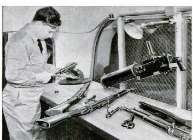-
Title (Dublin Core)
-
Soldiers in overalls keep our war machine rolling
-
Article Title and/or Image Caption (Dublin Core)
-
Soldiers in overalls keep our war machine rolling
-
extracted text (Extract Text)
-
AN ARMY officer who has what it takes
mae dead-tired men march all
night and attack in the morning, and
he can make scared-stiff ‘men fight and win
when the odds are all against them. That's
leadership—the most valuable quality that
an officer can have. But even ‘the best
leadership can't make a tank run “om &
broken track or get mileage out of a scout’
car with a cracked cylinder. It can’t grind
the valves of an ammunition truck, repair a
broken-down machine gun, or weld the
cracked axle of a howitzer. Those are jobs
for trained and skilled mechanics—for the
soldiers in overalls who keep the Army's
fighting machines running.
While our Army still is dangerously short
in the quantity of its mechanized weapons,
it is long on their quality. Our light tanks,
developed by the Ordnance Department, are
rated the world’s best. They have better
engines, better drives, better transmissions,
and better tracks than any other light
tanks; they are heavier, faster, and steadier
gun platforms. When it comes to the qual-
ity of their fighting vehicles, and their sys-
tem of keeping ’'em rolling, our mechan-
ized soldiers don’t have to take off their
snappy barrack caps to any army in the |
world. |
One of the purposes of the Third Army
maneuvers in western Louisiana this spring
was to give our Regular Army officers their |
first large-scale opportunity of practicing
the tactics and solving some of the problems |
of mechanized, motorized, and modernized
warfare. The maneuvers also provided a
stiff test of the Army's services of main-
tenance and supply. The mimic war |
meant two weeks of the hardest kind
of work for the 70,000 Regulars who
took part in it—especially for the
men who had the job of keeping roll-
ing the over 7,000 motor vehicles
which were driven hard both on the
roads and off them. There was plenty
of sweating done—but then, as
China’s General Chiang Kai-shek says,
“the more you sweat in peace, the less
you bleed in war.”
Following the light tanks of the
Mechanized Cavalry Brigade—then
the most thoroughly mechanized out-
fit in our Army—as they thundered
over the big maneuvers area on their
scouting and combat missions, I was
able to get a close-up of the operation
of the maintenance system of an or-
ganization which had 720 vehicles on
tracks and wheels—tanks, scout cars,
half tracks, trucks, passenger cars, and
motor cycles—and which regards attack-
ing at daybreak 150 or 200 miles away from
where hostile aviation reported it at dusk
as just another routine job.
Each troop has a maintenance section
which stays with it under all conditions to
make minor repairs both on the road and
on the battlefield. It is commanded by a
motor sergeant who is an expert trouble
shooter and travels in an armed scout car
followed by a truck which carries light re-
pair equipment, a small assortment of spare
parts, and an emergency
supply of gasoline and oil.
When a tank or scout car
is disabled it is pushed over
to the side of the road
and the rest of the troop
goes on forward to fight.
It is an unbreakable rule
that the officer in com-
mand must not wait for
cripples.
When the troop main-
tenance section comes up,
the motor sergeant checks
the disabled vehicle and
diagnoses the trouble. If
he has the time and
equipment for the job he
makes the repair, takes
the vehicle along with
him to the next halt, and
then sends it forward to
rejoin the troop. If he
can't make the repair, he
tags the job with his diag-
nosis, and leaves it. Its
crew always stays with a
disabled tank or scout car.
s0 that as soon as it has
been repaired ithev can
take it back into action where it belongs.
Following the regiment on the march is
the regimental maintenance section, which
carries witl. it a larger assortment of spare
parts and is equipped to handle jobs such
as changing tank tracks and installing new
shaft assemblies. When it comes up to a
disabled fighting vehicle the staff sergeant
who is its chief mechanic rechecks the job,
and if an immediate repair is practicable
leaves a crew to make it. If a roadside
repair can't be made, he has a wrecker
tow the cripple to where the regiment is
going to bivouac for the night, and the
repair is made there. When there is fight-
ing going on, a regimental service park
is established a few miles back of the
combat zone. Disabled vehicles are re-
ported to it by radio, and crews are sent
out to repair them on the battlefield or to
tow them in.
Jobs which are too big to be handled by
the regimental maintenance sections are
taken over by the brigade's ordnance main-
tenance company, which has machine-shop
trucks, welding apparatus, and other equip-
ment which, while sturdy, is light enough
to be carried in trucks. This organization
can handle almost any repair job, even
that of installing a new engine. It takes
with it into the field two complete engine
assemblies for each fifty tanks. Its 200-
odd highly-trained soldier-mechanics set up
their shop in a big square tent brightly
lighted by electricity supplied by a genera-
tor truck. Often they work all night to
make good on their boast that, if it is
humanly possible, they always have every
disabled vehicle ready to go when the
column pulls out in the morning.
There will be one of these maintenance
companies, probably increased in man-
power, in each of the two divisions of the
new Armored Corps now being organized.
Men now are being trained to do this
specialized mechanical work of the Army's
most modern fighting outfit at schools re-
cently established at Fort Benning, Ga., and
Fort Riley, Kans.
As important as keeping a mechanized
force's fighting vehicles in perfect mechan-
ical condition is the job of keeping them
supplied with fuel. There's
nothing in war more useless
or more helpless than a tank
with an empty gas tank.
Having a supply of fuel at
the right place at the right
moment always demands
careful planning and often
demands hard work. Tank
trucks have been tried and
discarded. Now cargo trucks
carry the fuel in ten-gallon
cans which, while the column
is halted, are dropped off at
each vehicle. This method
saves time, and time is the
determining factor in to-
day's warfare.
Attached to each of
the two army corps we
now have organized
there is a corps ordnance
battalion, and equipment
is being procured for
additional battalions so
that as the expanding
Army adds new corps
there will be a battalion
for each of them.
Each man in these bat-
talions is trained to ex-
pertness in some me-
chanical operation. After
he has mastered that
particular job he is
trained to handle other
jobs. All the equipment
is carried on trucks, and
most of it is used on
them, So the field shops
are ready for work a few minutes after the
trucks have scattered through some patch
of woods which will give them cover against
air attacks. Included in the equipment are
field welding outfits, machine-shop trucks,
and special firearms-repair trucks which
carry extensive assortments of spare parts
and the tools necessary for the repair of
machine guns, rifles, and pistols.
One of the jobs I watched being done dur-
ing the Louisiana maneuvers was the weld-
ing of the broken axle of a 155-millimeter
howitzer, without taking the big weapon
out of its firing position.
In its various post shops the Ordnance
Department has sturdy but comparatively
light machine-tool equipment capable of
doing all the work of a large job shop. In
war this would be taken into the field and
used by ordnance
maintenance battalions or regiments at-
tached to each field army.
The Motor Transport Service, a branch
of the Quartermaster Corps, is responsible
for the maintenance and repair of all the
Army's motor vehicles except tanks, scout
cars, and tractors used to haul artillery.
That's another big task. Even our small
“streamline” divisions include in their
equipment 1,357 trucks, trailers, passenger
cars, and motor cycles.
The job of the Motor Transport men is
to get spare parts and do repair work as
far forward toward the fighting line as is
possible—to keep vehicles working where
they are most needed and to keep them
from drifting back to the base for repairs.
There is a motor maintenance platoon in
the headquarters or service company of
each regiment. In the headquarters com-
pany of the quartermaster battalion of
each division there is a light maintenance
platoon, which probably soon will be in-
creased to a company, which supplies
parts and gives technical advice to the regi-
mental platoons, but does as little mechan-
ical work as possible. The divisional pla-
toons are supported by light maintenance
companies, which have truck shops equipped
to do jobs such as welding and cutting,
frame straightening, brake relining, bat-
tery charging, and valve grinding and seat-
ing. There also are maintenance com-
panies attached to each army corps, and in
war there would be a heavy maintenance
company, equipped for major repairs and
overhadle with cach field army.
Any soldiers or civilians who had doubts
about the deadly effectiveness of mecha-
nized war weapons lost them suddenly on
the day last spring when the 2,000 tanks the
Germans had massed near Sedan blasted a
wide and bloody lane through the French
defense lines and made it possible for the
German Army to win the stupendous battle
of France. That shattering, pulverizing at-
tack by Mars’ mechanical monsters brought
to terrible maturity the mechanized war-
fare which had been born on a misty morn-
ing in 1916 when the British sent their first
awkward and undependable tanks lurching
over the shell-pocked Somme battlefield.
To win in the intensified lightning war-
fare of today an army must have fighting
machines, and it must have soldier-mechan-
ics who have been trained to keep the ma-
chines running. There aren't any soldiers
who are more vitally necessary than the
soldiers who wear overalls.
-
Language (Dublin Core)
-
eng
-
Date Issued (Dublin Core)
-
1940-12
-
pages (Bibliographic Ontology)
-
84-88, 232
-
Rights (Dublin Core)
-
Public domain
-
Archived by (Dublin Core)
-
Sami Akbiyik
-
Marco Bortolami (editor)
 Popular Science Monthly, v. 137, n. 6, 1940
Popular Science Monthly, v. 137, n. 6, 1940
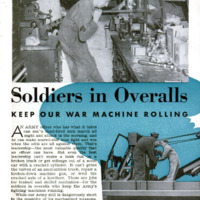 Ekran Resmi 2022-02-02 18.10.53.png
Ekran Resmi 2022-02-02 18.10.53.png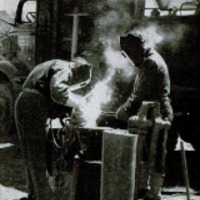 Ekran Resmi 2022-02-02 18.11.01.png
Ekran Resmi 2022-02-02 18.11.01.png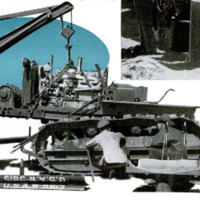 Ekran Resmi 2022-02-02 18.11.07.png
Ekran Resmi 2022-02-02 18.11.07.png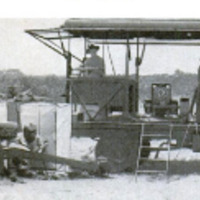 Ekran Resmi 2022-02-02 18.11.15.png
Ekran Resmi 2022-02-02 18.11.15.png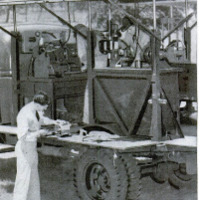 Ekran Resmi 2022-02-02 18.11.20.png
Ekran Resmi 2022-02-02 18.11.20.png Ekran Resmi 2022-02-02 18.11.25.png
Ekran Resmi 2022-02-02 18.11.25.png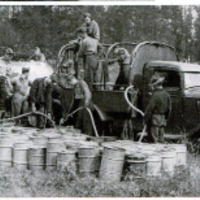 Ekran Resmi 2022-02-02 18.11.29.png
Ekran Resmi 2022-02-02 18.11.29.png Ekran Resmi 2022-02-02 18.11.35.png
Ekran Resmi 2022-02-02 18.11.35.png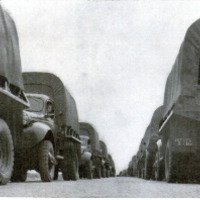 Ekran Resmi 2022-02-02 18.11.41.png
Ekran Resmi 2022-02-02 18.11.41.png





